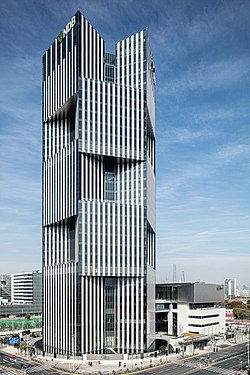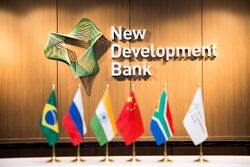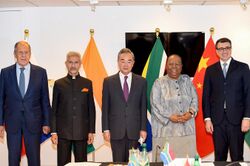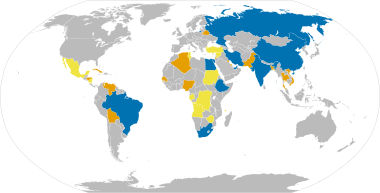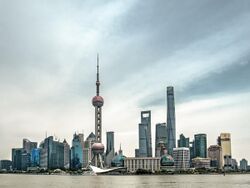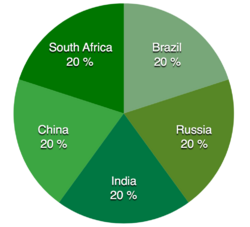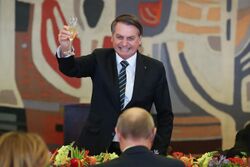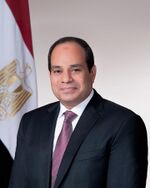BRICS
Topic: Organization
 From HandWiki - Reading time: 25 min
From HandWiki - Reading time: 25 min
 Logo of the 15th BRICS summit (2023) | |
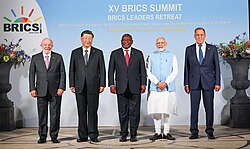 BRICS representatives at the 2023 summit, from left to right: Lula da Silva, Xi Jinping, Cyril Ramaphosa, Narendra Modi and Sergey Lavrov | |
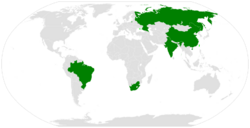 Map key:
Member states | |
| Abbreviation | BRICS |
|---|---|
| Named after | Founder member states' initials (in English) |
| Predecessor | BRIC (informal) |
| Founded at | Yekaterinburg, Russia (1st BRIC summit) |
| Type | Intergovernmental organization |
| Purpose | Political and economical |
| Fields | International politics |
Membership | 9 members
|
| Website | https://brics2023.gov.za/ |
BRICS is an intergovernmental organization comprising Brazil , Russia , India , China , South Africa , Egypt, Ethiopia, Iran, and the United Arab Emirates. Originally identified to highlight investment opportunities,[1] the grouping evolved into a cohesive geopolitical bloc, with their governments meeting annually at formal summits and coordinating multilateral policies since 2009. Bilateral relations among BRICS are conducted mainly on the basis of non-interference, equality, and mutual benefit.[2]
The founding countries of Brazil, Russia, India, and China held the first summit in Yekaterinburg in 2009, with South Africa joining the bloc a year later.[3][4] Egypt, Ethiopia, Iran and the United Arab Emirates joined the organization on 1 January 2024.[5][6]
Combined, the BRICS members encompass about 30% of the world's land surface and 45% of the global population.[lower-alpha 1] Brazil , Russia , India , and China are among the world's ten largest countries by population, area, and GDP (PPP). All five initial member states are members of the G20, with a combined nominal GDP of US$28 trillion (about 27% of the gross world product), a total GDP (PPP) of around US$57 trillion (33% of global GDP PPP), and an estimated US$4.5 trillion in combined foreign reserves (as of 2018).[8][9]
The BRICS countries are considered the foremost geopolitical rival to the G7 bloc of leading advanced economies, implementing competing initiatives such as the New Development Bank, the BRICS Contingent Reserve Arrangement, the BRICS pay, the BRICS Joint Statistical Publication and the BRICS basket reserve currency.
BRICS has received both praise[10][11][12][13] and criticism[14][15][16] from numerous commentators.
History
Founding
The term BRIC was originally developed in the context of foreign investment strategies. It was introduced in the 2001 publication, Building Better Global Economic BRICs by then-chairman of Goldman Sachs Asset Management, Jim O'Neill.[17][18]
The foreign ministers of the initial four BRIC General states (Brazil, Russia, India, and China) met in New York City in September 2006 at the margins of the General Debate of the UN Assembly, beginning a series of high-level meetings.[19] A full-scale diplomatic meeting was held in Yekaterinburg, Russia, on 16 June 2009.[20]
The BRIC grouping's 1st formal summit, also held in Yekaterinburg, commenced on 16 June 2009,[21] with Luiz Inácio Lula da Silva, Dmitry Medvedev, Manmohan Singh, and Hu Jintao, the respective leaders of Brazil, Russia, India, and China, all attending.[22] The summit's focus was on improving the global economic situation and reforming financial institutions, and discussed how the 4 countries could better co-operate in the future.[21][22] There was further discussion of ways that developing countries, such as 3/4 of the BRIC members, could become more involved in global affairs.[22]
In the aftermath of the 2009 Yekaterinburg summit, the BRIC nations announced the need for a new global reserve currency, which would have to be "diverse, stable and predictable."[23] Although the statement that was released did not directly criticize the perceived "dominance" of the United States dollar – something that Russia had criticized in the past – it did spark a fall in the value of the dollar against other major currencies.[24]
2010 expansion
In 2010, South Africa began efforts to join the BRIC grouping, and the process for its formal admission began in August of that year.[25] South Africa officially became a member nation on 24 December 2010, after being formally invited by China to join[26] and subsequently accepted by other BRIC countries.[25] The group was renamed BRICS – with the "S" standing for South Africa – to reflect the group's expanded membership.[27] In April 2011, the President of South Africa, Jacob Zuma, attended the 2011 BRICS summit in Sanya, China, as a full member.[28][29][30]
New Development Bank
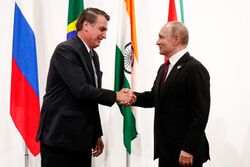
In June 2012, the BRICS nations pledged $75 billion to boost the lending power of the International Monetary Fund (IMF). However, this loan was conditional on IMF voting reforms.[31] In March 2013, during the fifth BRICS summit in Durban, the member countries agreed to create a global financial institution to cooperate with the western-dominated IMF and World Bank.[32] They planned to set up this New Development Bank by 2014.[33] However, disputes relating to burden sharing and location slowed down the agreements.[citation needed]
At the BRICS leaders meeting in St Petersburg in September 2013, China committed $41 billion towards the pool; Brazil, India, and Russia $18 billion each; and South Africa $5 billion. China, who held the world's largest foreign exchange reserves and contributes the bulk of the currency pool, wanted a more significant managing role. China also wanted to be the location of the reserve.[34] In October 2013, Russia's Finance Minister Anton Siluanov said that creating a $100 billion in funds designated to steady currency markets would be taken in early 2014. The Brazilian finance minister, Guido Mantega, confirmed that the fund would be created by March 2014.[35] However, by April 2014, the currency reserve pool and development bank had yet to be set up, and the date was rescheduled to 2015.[36] One driver for the BRICS development bank is that the existing institutions primarily benefit extra-BRICS corporations, and the political significance is notable because it allows BRICS member states "to promote their interests abroad... and can highlight the strengthening positions of countries whose opinion is frequently ignored by their developed American and European colleagues."[citation needed]
In July 2014, during the sixth BRICS summit in Fortaleza, the BRICS signed the document to create the US$100 billion New Development Bank (formerly known as the "BRICS Development Bank") and a reserve currency pool worth over another US$100 billion. Documents on cooperation between BRICS export credit agencies and an agreement of cooperation on innovation were also inked.[citation needed] The Fortaleza summit was followed by a BRICS meeting with the Union of South American Nations presidents in Brasilia.[37]
Other initiatives
Since 2011, the National Institutes of Statistics of the BRICS group of countries (IBGE, Rosstat, the National Bureau of Statistics of China, the Central Statistics Office (India) and Statistics South Africa) produce an annual joint statistical publication in order to put statistical production in perspective, compare adopted methodologies and statistical results. The publication serves as single data platform for the mutual benefit of participating countries.
Since 2012, the BRICS group of countries have been planning an optical fibre submarine communications cable system to carry telecommunications between the BRICS countries, known as the BRICS Cable.[38] Part of the motivation for the project was the spying of the U.S. National Security Agency on all telecommunications that flowed in and out of United States territory.[39] As of 2023, construction of the proposed cable network had not started.[citation needed]
After the 2015 summit, the respective communications ministers, under a Russian proposal, had a first summit for their ministries in Moscow in October where the host minister, Nikolai Nikiforov, proposed an initiative to further tighten their information technology sectors and challenge the monopoly of the United States in the sector.[citation needed]
In August 2019, the communications ministers of the BRICS countries signed a letter of intent to cooperate in the Information and Communication Technology sector. This agreement was signed in the fifth edition of meeting of communication ministers of countries member of the group[40] held in Brasília, Brazil.
The New Development Bank plans on giving out $15 billion to member states to help their struggling economies. Member countries are hoping for a smooth comeback and a continuation of economic trade pre-COVID-19. The 2020 BRICS summit was held virtually in St. Petersburg, Russia and discussed how to handle the COVID-19 pandemic and how to fix the multilateral system via reforms.[41] During the 13th BRICS summit, in 2021, Indian Prime Minister Narendra Modi called for a transparent investigation into the origins of COVID-19 under the World Health Organization with the full cooperation of "all countries", and Chinese leader Xi Jinping spoke directly afterwards, calling on BRICS countries to "oppose politicisation" of the process.[42]
In May 2023, South Africa announced that they would be giving diplomatic immunity to Vladimir Putin and other Russian officials so that they could attend the 15th BRICS Summit despite the ICC arrest warrant for Putin.[43][44] In July 2023, the Russian president announced that he will not personally attend the BRICS summit in Johannesburg on 22–24 August despite good relations with the South African government. Russian news channels noted that Putin will remotely participate online in all BRICS leaders’ sessions, including its Business Forum, and also deliver his remarks virtually.[45]
2024 expansion
In August 2023, at the 15th BRICS Summit, South African President Cyril Ramaphosa announced that 6 emerging market group countries (Argentina , Egypt, Ethiopia, Iran, Saudi Arabia, and the United Arab Emirates) had been invited to join the bloc. Full membership was scheduled to take effect on 1 January 2024.[46][47][48] However, the Argentine general election in November 2023 led to a change in president to Javier Milei, who had committed to withdraw the country's membership application.[49] On 30 November 2023, incoming Foreign Minister of Argentina Diana Mondino confirmed that Argentina will not join the BRICS.[50] On 29 December 2023 the Government of Argentina sent a letter to all BRICS leaders to officially announce its withdrawal from the application process.[51]
The aim of latest expansion is touted as part of a plan to build a multipolar world order that puts weight to hitherto subdued voices of the Global South and brings them to the centre of the world agenda.[52]
Summits
The grouping has held annual summits since 2009, with member countries taking turns to host. Prior to South Africa's admission, two BRIC summits were held, in 2009 and 2010. The first five-member BRICS summit was held in 2011. The most recent BRICS leaders' summit took place virtually on 23 June 2022 hosted by China.[53][54] India hosted the BRICS 2021 summit in New Delhi and, amid tensions with China, Chinese leader Xi Jinping had made a soft move by supporting India's Chairmanship in 2021.[55]
| Sr. No. | Date(s) | Host country | Host leader | Location | Notes |
|---|---|---|---|---|---|
| 1st | 16 June 2009 | Dmitry Medvedev | Yekaterinburg (Sevastianov's House) | The summit was to discuss the global recession taking place at the time, future cooperation among states, and trade. Some of the specific topics discussed were food, trade, climate trade, and security for the members. They called out for a more influential voice and representation for up-and-coming markets. Note at the time South Africa was not yet admitted to the BRICS organization at the time.[56] | |
| 2nd | 15 April 2010 | Luiz Inácio Lula da Silva | Brasília (Itamaraty Palace) | Guests: Jacob Zuma (President of South Africa) and Riyad al-Maliki (Foreign Minister of the Palestinian National Authority). The second summit continued on the conversation of the global recession and how to recover. They had a conversation on the IMF, climate change, and more ways to form cooperation among states.[56] | |
| 3rd | 14 April 2011 | Hu Jintao | Sanya (Sheraton Sanya Resort) | First summit to include South Africa alongside the original BRIC countries. The third summit had members debating on the global and internal economies of countries.[56] | |
| 4th | 29 March 2012 | Manmohan Singh | New Delhi (Taj Mahal Hotel) | The BRICS Cable announced an optical fibre submarine communications cable system that carries telecommunications between the BRICS countries. The fourth summit discussed how the organization could prosper from the global recession and how they could take advantage of that to help their economies. BRICS had the intention of improving their global power and providing adequate development for their state.[57] | |
| 5th | 26–27 March 2013 | Jacob Zuma | Durban (Durban ICC) | The fifth summit discusses the New Development Bank proposition and Contingent Reserve Agreement. BRICS also announced the Business Council and its Think Tank Council.[57] | |
| 6th | 14–17 July 2014 | Dilma Rousseff | Fortaleza (Centro de Eventos do Ceará)[58] | BRICS New Development Bank and BRICS Contingent Reserve Arrangement agreements signed.[59] The members of BRICS conversed with each other about political coordination, development, and economic growth. They established the Fortaleza Declaration and Action Plan.[60] | |
| 7th | 8–9 July 2015 | Vladimir Putin | Ufa (Congress Hall)[61] | Joint summit with SCO-EAEU. The seventh summit discussed global, economic problems, and better ways to foster cooperation among member states.[60] | |
| 8th | 15–16 October 2016 | Narendra Modi | Benaulim (Taj Exotica) | Joint summit with BIMSTEC. The eighth BRICS summit debated on topics like counter-terrorism, economies, and climate change. BRICS also issued the Goa Declaration and Action Plan, hoping to harden their relationships.[62] | |
| 9th | 3–5 September 2017 | Xi Jinping | Xiamen (Xiamen International Conference Center) | Joint summit with EMDCD. The ninth summit was an event that talked about a bright future for BRICS and what their goals intend to be. They still covered and debated international and regional issues with one another; hopeful to keep moving forward.[62] | |
| 10th | 25–27 July 2018 | Cyril Ramaphosa | Johannesburg (Sandton Convention Centre) | The tenth summit had the members discuss their rising industries. Hoping they can cut a bigger slice of the industry market. | |
| 11th | 13–14 November 2019 | Jair Bolsonaro | Brasília (Itamaraty Palace)[55] | The eleventh summit discussed advancements in the BRICS's science and innovation fields. Primarily trying to advance technology and digital currency. They made mutual agreements to help stop drug trafficking and organized crime; both internationally and internally | |
| 12th | 21–23 July 2020 (postponed due to COVID-19 pandemic)[63] 17 November 2020 (video conference)[64] |
Vladimir Putin | Saint Petersburg[65] | Joint summit with SCO. Discussing a mutual agreement on helping BRICS member countries to help foster better living standards and quality of life for each country's people. Plans on focusing on peace, economies, and cultural societal issues.[66] | |
| 13th | 9 September 2021 (video conference) | Narendra Modi | New Delhi | BRICS Games 2021[67] | |
| 14th | 23 June 2022 (video conference) | Xi Jinping | Beijing | A major development on the summit was creation of a new, basket type reserve currency. The currency, which is challenging US dollar, combines BRICS currencies and is backed by precious metals. | |
| 15th | 22–24 August 2023 | Cyril Ramaphosa | Johannesburg (Sandton Convention Centre) | Argentina , Egypt, Ethiopia, Iran, Saudi Arabia, and the United Arab Emirates were invited to join the bloc. Full membership took effect on 1 January 2024.[47][48] On December 29, 2023, the Government of Argentina sent a letter to all BRICS leaders officially declining the invitation to join the bloc[51] while Saudi Arabia confirmed its membership on 31st January 2024.[68] | |
| 16th | October 2024 | TBD | Kazan | [69] |
Member states
| Flag | Country |
Capital |
Area (km2) |
Population (2016) |
Density (/km2) |
GDP per cap. (PPP)[70] |
HDI[62][71] | Currency |
Official languages | Leaders | Accession |
|---|---|---|---|---|---|---|---|---|---|---|---|
| Brazil Federative Republic of Brazil |
Brasília | 8,515,767 | 203,062,512 | 23.8 | 20,079 | 0.754 | Brazilian real (R$) (BRL) |
Portuguese also see Languages of Brazil |
Head of State: Luiz Inácio Lula da Silva | September 2006 | |
| Russia Russian Federation |
Moscow | 17,075,400 | 146,519,759 | 8.3 | 35,310 | 0.798 | Russian rouble (₽) (RUB) |
Russian also see Languages of Russia |
Head of State: Vladimir Putin Head of Government: Mikhail Mishustin |
September 2006 | |
| India Republic of India |
New Delhi | 3,287,240 | 1,284,480,000 | 364.4 | 9,183 | 0.640 | Indian rupee (₹) (INR) |
Hindi (Devanagari script) English Also see Languages of India |
Head of State: Droupadi Murmu Head of Government: Narendra Modi |
September 2006 | |
| China [lower-alpha 2] People's Republic of China |
Beijing | 9,640,011[lower-alpha 3] | 1,374,820,000 | 139.6 | 23,309 | 0.727 | Renminbi (Chinese yuan, ¥) (CNY) |
Standard Chinese[72] written in simplified characters[72] see also languages of China |
Head of State: Xi Jinping Head of Government: Li Qiang |
September 2006 | |
| South Africa Republic of South Africa |
Pretoria (executive) Cape Town (legislative) Bloemfontein (judicial) |
1,221,037 | 58,048,332 | 42.4 | 16,211 | 0.713 | South African rand (R) (ZAR) |
12 languages | Head of State: Cyril Ramaphosa | 24 December 2010 | |
| Egypt Arab Republic of Egypt |
Cairo | 1,010,408 | 105,231,000 | 103.56 | 17,123 | 0.731 | Egyptian pound (LE) (EGP) |
Arabic | Head of State: Abdel Fattah el-Sisi Head of Government: Moustafa Madbouly |
1 January 2024 | |
| Ethiopia Federal Democratic Republic of Ethiopia |
Addis Ababa | 1,104,300 | 105,163,988 | 92.7 | 3,719 | 0.498 | Ethiopian birr (BR) (ETB) |
Afar Amharic Oromo Somali Tigrinya |
Head of State: Sahle-Work Zewde Head of Government: Abiy Ahmed |
1 January 2024 | |
| Iran Islamic Republic of Iran |
Tehran | 1,648,195 | 79,011,700 | 48.0 | 19,942 | 0.766 | Iranian rial (Rl) (IRR) |
Persian | Head of State: Ali Khamenei Head of Government: Ebrahim Raisi |
1 January 2024 | |
| Saudi Arabia Kingdom of Saudi Arabia |
Riyadh | 2,149,690 | 38,401,000 | 15 | 67,019 | 0.875 | Saudi riyal (SR) (SAR) | Arabic | Head of State: Salman Head of Government: Mohammed bin Salman |
1 January 2024 | |
| United Arab Emirates | Abu Dhabi | 83,600 | 9,282,410[73] | 121 | 88,962 | 0.911 | UAE dirham (AED) | Arabic | Head of State: Mohamed bin Zayed Al Nahyan Head of Government: Mohammed bin Rashid Al Maktoum |
1 January 2024 |
Application and expansion process
While there is currently no formal application process to join BRICS, any hopeful government must receive the unanimous backing of all member states to receive an invitation. It was not until the early 2020s that discussions regarding allowing new states to join the club were widely held. Leaders and senior diplomats from the participating members began to discuss the prospect of adding additional members to the organization at that point.[74][75][76]
In August 2023, at the 15th BRICS Summit, South African President Cyril Ramaphosa announced that Argentina , Egypt, Ethiopia, Iran, Saudi Arabia and the United Arab Emirates had been invited to join the organisation on 1 January 2024.[47][48]
On 30 December 2023, the new government of Argentina, which formally submitted an application for BRICS membership under Alberto Fernández's government in 2022, officially declined the offer to join the bloc due to the new government's different foreign policy.[50][77]
On 1 January 2024, Egypt, Ethiopia, Iran and the United Arab Emirates officially joined the bloc. Saudi Arabia officially joined on 31st January 2024[78].
Countries that have applied for membership
A total of 15 countries[79] have formally applied to join BRICS, listed as follows:[80]
1 - Applied in 2023.
2 - Applied in 2022, Expected to join in 2nd expansion round.[88]
Potential candidates
In addtion, the following countries have expressed interest in joining BRICS:[89]
|
Financial architecture
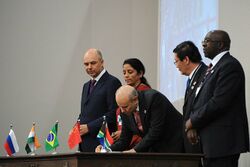
The financial architecture of BRICS is made of the New Development Bank (NDB) and the Contingent Reserve Arrangement (CRA). These components were signed into treaty in 2014 and became active in 2015.
New Development Bank
The New Development Bank (NDB), formally referred to as the BRICS Development Bank,[95] is a multilateral development bank operated by the five BRICS states. The bank's primary focus of lending is infrastructure projects[96][97] with authorized lending of up to $34 billion annually.[97] South Africa hosts the African headquarters of the bank.[98] The bank has a starting capital of $50 billion, with wealth increased to $100 billion over time.[99] Brazil, Russia, India, China, and South Africa initially contributed $10 billion each to bring the total to $50 billion.[98][99] As of 2020, it had 53 projects under way worth around $15 billion.[100]
In 2021, Bangladesh, Egypt, the United Arab Emirates and Uruguay joined the NDB.[101]
BRICS Contingent Reserve Arrangement
The BRICS Contingent Reserve Arrangement (CRA) is a framework for providing protection against global liquidity pressures.[96][99][102] This includes currency issues where members' national currencies are being adversely affected by global financial pressures.[96][102] Emerging economies that experienced rapid economic liberalization went through increased economic volatility, bringing an uncertain macroeconomic environment.[103] The CRA competes with the International Monetary Fund (IMF). Along with the New Development Bank, it is an example of increasing South-South cooperation.[96] It was established in 2015 by the BRICS countries. The legal basis is formed by the Treaty for the Establishment of a BRICS Contingent Reserve Arrangement, signed in Fortaleza in July 2014. With its inaugural meetings of the BRICS CRA Governing Council and Standing Committee, held on 4 September 2015, in Ankara, Turkey[104] it entered into force upon ratification by all BRICS states, announced at the 7th BRICS summit in July 2015.
BRICS payment system
At the 2015 BRICS summit in Russia, ministers from the BRICS states initiated consultations for a payment system that would be an alternative to the SWIFT system. The stated goal was to initially move to settlements in national currencies.[105] The Central Bank of Russia highlighted the main benefits as backup and redundancy in case there were disruptions to the SWIFT system.[106]
China also launched its own alternative to SWIFT: the Cross-Border Interbank Payment System, which enables financial institutions worldwide to send and receive information about financial transactions.Cite error: Closing </ref> missing for <ref> tag[107][108] Fair and easier international trade as well as a major reduction in costs of transactions would be some of the reasons why the countries could forge a currency union.[109]
Reception
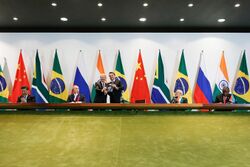
In 2012, Hu Jintao, the then General Secretary of the Chinese Communist Party and President of China, described the BRICS countries as defenders and promoters of developing countries and a force for world peace.[10] Western analysts have highlighted potential divisions and weaknesses in the grouping, including significant economic instabilities,[110][111][112][113] disagreements among the members over the UN Security Council reform,[114] and India and China's disputes[115] over territorial issues.[11]
On 9 April 2013, Isobel Coleman, director of the Civil Society, Markets, and Democracy Program at the American think tank Council on Foreign Relations, and later U.S. representative to the UN, claimed that the BRICS members share a lack of consensus. They uphold drastically different political systems, from a vibrant democracy in Brazil to entrenched oligarchy in Russia, and their economies are little integrated and are different in size by orders of magnitude. She also claimed that the significant difference in GDP influences the reserves: China accounts for over 41% of the contribution, which in turn leads to its bigger political say within the association.[116]
In 2014, the Indian Marxist author Vijay Prashad raised the limitations of the BRICS as a political and economic "locomotive of the South" because they follow neoliberal policies. They have established neither new counter-balancing institutions nor come up with an alternative ideology. Furthermore, the BRICS project, argues Prashad, has no ability to challenge the primacy of the United States and NATO.[117]
After the 2023 BRICS Summit, Con Coughlin, defence and foreign affairs editor at The Daily Telegraph, claimed "the challenge BRICS presents to the established world order seems destined to failure" and accused the organization of being used by China as a vehicle for expanding its global influence. Coughlin also noted the contradictions within the organization, such as the border dispute between China and India, and called for greater Western engagement with India as part of a new strategic alliance.[16]
A multi-year study at Tufts University found that the "common portrayal of BRICS as a China-dominated group primarily pursuing anti-U.S. agendas is misplaced ... The BRICS countries connect around common development interests and a quest for a multipolar world order in which no single power dominates. Yet BRICS consolidation has turned the group into a potent negotiation force that now challenges Washington's geopolitical and economic goals".[118]
According to Thomas Hill, Atlantic Council, the de-dollarization efforts within BRICS, particularly in North Africa, present a significant challenge to US interests. The inclusion of Egypt and the enthusiasm in Algiers and Tunis suggest that North African states may actively support BRICS's priority of de-dollarization. This poses a threat to the US, as a coordinated de-dollarization effort in the region could diminish American influence and impact existing trade agreements. The expansion of BRICS raises concerns for US policymakers, given the group's commitment to global de-dollarization, which aims to replace the dollar with the "R5" or “the renminbi, ruble, rupee, real, and rand”, or with other multilateral central bank digital currency (CBDC) as the new global currency. This shift could limit the US ability to run deficits and maintain low interest rates. Moreover, de-dollarization would undermine the effectiveness of US sanctions, relying on the SWIFT system, as BRICS seeks alternative financial systems, potentially making SWIFT obsolete.[119]
BRICS Pro Tempore Presidency
The group at each summit elects one of the heads of state of the component countries to serve as President Pro Tempore of the BRICS.
In 2019, the pro tempore presidency was held by the president of Brazil.[120]
The theme of the 11th BRICS summit was "BRICS: economic growth for an innovative future", and the priorities of the Brazilian Pro Tempore Presidency for 2019 are the following – Strengthening of the cooperation in Science, technology and innovation; Enhancement of the cooperation on digital economy; Invigoration of the cooperation on the fight against transnational crime, especially against organized crime, money laundering and drug trafficking; Encouragement to the rapprochement between the New Development Bank (NDB) and the BRICS Business Council.[121]
Currently the new President Pro Tempore is Russia and their goals are: investing into BRICS countries in order to strengthen everyone's economies, cooperating in the energy and environmental industries, helping with young children and coming up with resolutions on migration and peacekeeping.[122]
Current leaders
Current leading highest state representatives:
| Member | |||||
|---|---|---|---|---|---|
| Image | 
|
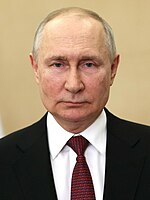
|
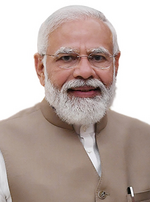
|
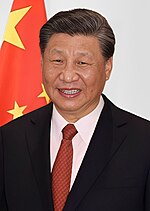
|

|
| Name | Luiz Inácio Lula da Silva | Vladimir Putin | Narendra Modi | Xi Jinping | Cyril Ramaphosa |
| Position | President of Brazil | President of Russia | Prime Minister of India | President of China | President of South Africa |
| Member | ||||
|---|---|---|---|---|
| Image | 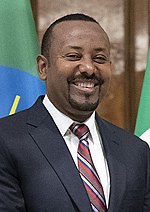
|
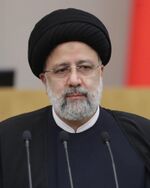
|
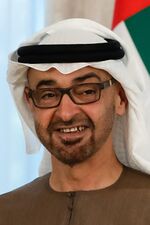
| |
| Name | Abdel Fattah el-Sisi | Abiy Ahmed | Ebrahim Raisi | Mohamed bin Zayed Al Nahyan |
| Position | President of Egypt | Prime Minister of Ethiopia | President of Iran | President of the United Arab Emirates |
See also
- Organization:Belt and Road Initiative – China's global infrastructure project
- Finance:Developing country – Nation with a lower living standard relative to more developed countries
- East–West dichotomy – Perceived difference between the Eastern and Western worlds
- Finance:List of country groupings
- Finance:List of multilateral free-trade agreements
- Organization:MIKTA – Informal partnership between Mexico, Indonesia, South Korea, Turkey and Australia
- Unsolved:Potential superpowers – Entity speculated to become a superpower
Notes
- ↑ The BRICS have a combined area of 44,300,000 km2 (17,100,000 sq mi) and an estimated total population of about 3.67 billion.[7]
- ↑ The sovereignty of China is disputed. Since the conclusion of the Chinese Civil War, the Republic of China on Taiwan still views itself as the continuation of the former Chinese republic, with legitimate sovereignty over mainland China despite no actual control. See: Political status of Taiwan, Retreat of the Republic of China to Taiwan, Four-Stage Theory of the Republic of China, Two Chinas, One-China policy, and Cross-strait relations.
- ↑ The actual area under PRC control is 9,596,960.
References
- ↑ "Goldman's BRIC Era Ends as Fund Folds After Years of Losses". 8 November 2015. https://www.bloomberg.com/news/articles/2015-11-08/goldman-s-bric-era-ends-as-fund-closes-after-years-of-losses.
- ↑ Gutemberg Pacheco Lopes Junior. "The Sino-Brazilian Principles in a Latin American and BRICS Context: The Case for Comparative Public Budgeting Legal Research; Wisconsin International Law Journal; 13 May 2015". https://uwlaw-omeka.s3.us-east-2.amazonaws.com/original/08e149ff130e80d68a807d83638d111fb4472552.pdf.
- ↑ https://www.reuters.com/world/what-is-brics-who-are-its-members-2023-08-21/#:~:text=WHO%20ARE%20THE%20MEMBERS%3F,grouping%20became%20known%20as%20BRICS .
- ↑ Oliver Stuenkel (2020). The BRICS and the Future of Global Order (2 ed.). Lexington Books. p. 1. ISBN 978-0739193211.
- ↑ "BRICS expansion: five countries join ranks". 2 January 2024. https://www.africanews.com/2024/01/02/brics-expansion-five-countries-join-ranks/.
- ↑ "Iran, UAE, Egypt and Ethiopia join BRICS" (in en-US). 2024-01-03. https://www.jpost.com/international/article-780601.
- ↑ "Total Population – Both Sexes". World Population Prospects, the 2019 Revision. United Nations Department of Economic and Social Affairs, Population Division, Population Estimates and Projections Section. June 2019. https://population.un.org/wpp/Download/Files/1_Indicators%20(Standard)/EXCEL_FILES/1_Population/WPP2019_POP_F01_1_TOTAL_POPULATION_BOTH_SEXES.xlsx.
- ↑ "Report for Selected Countries and Subjects" (in en-US). https://www.imf.org/en/Publications/WEO/weo-database/2023/April/weo-report.
- ↑ "Amid BRICS' rise and 'Arab Spring', a new global order forms" . The Christian Science Monitor. 18 October 2011. Retrieved 20 October 2011.
- ↑ 10.0 10.1 "Brics a force for world peace, says China". 8 August 2012. http://www.businessday.co.za/articles/Content.aspx?id=168422.
- ↑ 11.0 11.1 Khadija Patel (3 April 2012). "Brics summit exposes the high wall between India and China". Daily Maverick. http://www.atimes.com/atimes/Global_Economy/ND03Dj01.html.
- ↑ "ILO head praises BRICS countries' commitment to social dialogue" (in en). ILO. 2018-08-03. http://www.ilo.org/global/about-the-ilo/newsroom/news/WCMS_636211/lang--en/index.htm.
- ↑ Wolff, Richard D. (3 October 2022). "BRICS: the powerful global alliance" (in en). https://canadiandimension.com/articles/view/brics-the-powerful-global-alliance.
- ↑ Maitra, Sumantra (18 April 2013). "BRICS – India is the biggest loser". USINPAC. http://usinpac.com/blog/admin/brics-india-is-the-biggest-loser/.
- ↑ Blakeley, Grace (15 February 2023). "BRIC Nationalism Is No Alternative". Jacobin. https://jacobin.com/2023/02/bric-nationalism-is-no-alternative.
- ↑ 16.0 16.1 Coughlin, Con (24 August 2023). "Brics is now a motley crew of failing states" (in en-GB). The Daily Telegraph. ISSN 0307-1235. https://www.telegraph.co.uk/news/2023/08/24/brics-summit-india-china-russia-putin-xi-jinping/.
- ↑ Jim O'Neill (2009)."Building Better Global Economic BRICs" . Goldman Sachs. Retrieved 12 February 2015.
- ↑ Nagashybayeva, Gulnar (November 2016). "Research Guides: BRICS: Sources of Information: Introduction" (in en-US). https://guides.loc.gov/brics/introduction.
- ↑ "Information about BRICS". Brics6.itamaraty.gov.br. 27 March 2013. http://brics6.itamaraty.gov.br/about-brics/information-about-brics.
- ↑ "Cooperation within BRIC" . Kremlin.ru. Retrieved 16 June 2009.
- ↑ 21.0 21.1 "First summit for emerging giants". BBC News. 16 June 2009. http://news.bbc.co.uk/1/hi/business/8102216.stm.
- ↑ 22.0 22.1 22.2 Bryanski, Gleb (26 June 2009). "BRIC demands more clout, steers clear of dollar talk". Reuters. https://www.reuters.com/article/marketsNews/idUSLG67435120090616.
- ↑ "BRIC wants more influence". Euronews. 16 June 2009. http://www.euronews.net/2009/06/16/bric-wants-more-influence/.
- ↑ Zhou, Wanfeng (16 June 2009). "Dollar slides after Russia comments, BRIC summit". Reuters. https://www.reuters.com/article/us-markets-forex-idUSTRE5530NQ20090616.
- ↑ 25.0 25.1 Smith, Jack A. (21 January 2011). "BRIC Becomes BRICS: Changes on the Geopolitical Chessboard". Foreign Policy Journal. http://www.foreignpolicyjournal.com/2011/01/21/bric-becomes-brics-changes-on-the-geopolitical-chessboard/2/.
- ↑ "China invites South Africa to join BRIC: Xinhua" (in en). Reuters. 24 December 2010. https://www.reuters.com/article/us-bric-safrica-idUSTRE6BN1DZ20101224.
- ↑ Blanchard, Ben and Zhou Xin (14 April 2011). "UPDATE 1-BRICS discussed global monetary reform, not yuan" . Reuters Africa. Retrieved 26 April 2013.
- ↑ "South Africa joins BRIC as full member". Xinhua. 24 December 2010. http://news.xinhuanet.com/english2010/china/2010-12/24/c_13662138.htm.
- ↑ "BRICS countries need to further enhance coordination: Manmohan Singh". 12 April 2011. http://timesofindia.indiatimes.com/india/BRICS-countries-need-to-further-enhance-coordination-Manmohan-Singh/articleshow/7961167.cms.
- ↑ "BRICS should coordinate in key areas of development: PM". 10 April 2011. http://www.indianexpress.com/news/brics-should-coordinate-in-key-areas-of-development-pm/775130/.
- ↑ "Russia says BRICS eye joint anti-crisis fund". Reuters. 21 June 2012. http://in.reuters.com/article/russia-brics-imf-idINDEE85K04C20120621.
- ↑ "Brics eye infrastructure funding through new development bank". 28 March 2013. https://www.theguardian.com/global-development/2013/mar/28/brics-countries-infrastructure-spending-development-bank.
- ↑ "India sees BRICS development bank agreed by 2014 summit". Reuters. 19 April 2013. http://in.reuters.com/article/g20-brics-india-idINDEE93I0DK20130419.
- ↑ "BRICS may decide on $100 billion fund early 2014 – Russia | Reuters". In.reuters.com. 11 October 2013. http://in.reuters.com/article/g20-brics-fund-idINL6N0I13N720131011.
- ↑ Silvio Cascione; Patricia Duarte (10 October 2013). "Brazil's Mantega urges Fed to communicate tapering 'clearly' | Reuters". In.reuters.com. http://in.reuters.com/article/us-brazil-economy-mantega-idINBRE9990WR20131010.
- ↑ "rbth.com: "BRICS countries to set up their own IMF" 14 Apr 2014". 14 April 2014. http://rbth.com/business/2014/04/14/brics_countries_to_set_up_their_own_imf_35891.html.
- ↑ "BRICS to launch bank, tighten Latin America ties" . Yahoo.com. 11 July 2014. Retrieved 13 February 2015.
- ↑ "Brics Cable Unveiled for Direct and Cohesive Communications Services between Brazil, Russia, India, China and South Africa". Bloomberg News. 16 April 2012. https://www.bloomberg.com/apps/news?pid=newsarchive&sid=aDLKQqIM.ZZ0.
- ↑ Rolland, Nadège (2 April 2015). "A Fiber-Optic Silk Road". The Diplomat. https://thediplomat.com/2015/04/a-fiber-optic-silk-road/.
- ↑ "BRICS countries to cooperate in ICT sector". https://www.telecompaper.com/news/brics-countries-to-cooperate-in-ict-sector--1304946.
- ↑ "BRICS To Allocate $15 Billion For Rebuilding Economies Hit By COVID-19". https://www.ndtv.com/india-news/coronavirus-brics-to-allocate-15-billion-for-rebuilding-economies-hit-by-covid-19-2220046.
- ↑ Haidar, Suhasini; Krishnan, Ananth (15 September 2021). "India, China avoided open clash over COVID-19 origins". The Hindu. https://www.thehindu.com/news/national/india-china-avoided-open-clash-over-origins-of-covid-19-virus/article36479981.ece.
- ↑ Carter, Sarah (2023-05-30). "South Africa moves to let Putin attend BRICS summit despite ICC arrest warrant over Ukraine war" (in en-US). https://www.cbsnews.com/news/south-africa-vladimir-putin-icc-arrest-warrant-ukraine-war-brics-immunity/.
- ↑ "South Africa's diplomatic dilemma with Putin". Deutsche Welle. 2 June 2023. https://www.dw.com/en/south-africas-diplomatic-dilemma-with-putin/a-65804176.
- ↑ Bartlett K. (July 19, 2023). "Putin won't attend a South Africa summit next month, avoiding possible arrest" NPR.org. Accessed 21 July 2023.
- ↑ Monteiro, Ana (2023-12-29). "BRICS to Grow as Saudi, Iran, UAE, Egypt, Ethiopia Join Ranks". https://www.bloomberg.com/news/articles/2023-12-29/brics-to-grow-as-saudi-iran-uae-egypt-ethiopia-join-ranks.
- ↑ 47.0 47.1 47.2 Sharma, Shweta (24 August 2023). "Brics countries agree major expansion as 6 countries invited to join" (in en). https://www.independent.co.uk/news/world/africa/brics-2023-summit-new-members-saudi-uae-iran-b2398553.html.
- ↑ 48.0 48.1 48.2 du Plessis, Carien; Miridzhanian, Anait; Acharya, Bhargav (24 August 2023). "BRICS welcomes new members in push to reshuffle world order" (in en). Reuters. https://www.reuters.com/world/brics-poised-invite-new-members-join-bloc-sources-2023-08-24/.
- ↑ "BRICS membership in doubt as opposition rejects move | Buenos Aires Times". https://www.batimes.com.ar/news/argentina/argentinas-brics-membership-in-doubt-as-opposition-rejects-move.phtml.
- ↑ 50.0 50.1 Bonelli, Matías (1 December 2023). "Diana Mondino confirmó que la Argentina no ingresará a los BRICS" (in es). El Cronista. https://www.cronista.com/economia-politica/diana-mondino-confirmo-que-la-argentina-no-ingresara-a-los-brics/.
- ↑ 51.0 51.1 "El gobierno de Javier Milei oficializó que la Argentina no entrará a los Brics" (in es). 2023-12-29. https://www.lanacion.com.ar/politica/el-gobierno-de-javier-milei-oficializo-que-la-argentina-no-entrara-a-los-brics-nid29122023/.
- ↑ Ismail, Sumayya (2023-08-24). "Saudi Arabia, Iran among 6 nations invited to join BRICS" (in en). https://www.aljazeera.com/economy/2023/8/24/saudi-arabia-iran-to-join-brics-as-grouping-admits-six-new-members.
- ↑ "14th BRICS summit to be held in China: Check date, place and other details". The Economic Times. https://economictimes.indiatimes.com/news/india/14th-brics-summit-to-be-held-in-china-check-date-place-and-other-details/articleshow/92271827.cms.
- ↑ "China's Xi to host virtual BRICS leaders summit on June 23 - Xinhua" (in en). Reuters. 2022-06-17. https://www.reuters.com/world/china/chinas-xi-host-virtual-brics-leaders-summit-june-23-xinhua-2022-06-17/.
- ↑ 55.0 55.1 "BRICS BRASIL 2019 – Theme and priorities". http://brics2019.itamaraty.gov.br/en/2019-brazilian-presidency/theme-and-priorities.
- ↑ 56.0 56.1 56.2 "What is BRICS | Africa Facts" (in en-US). 15 October 2018. https://africa-facts.org/what-is-brics/.
- ↑ 57.0 57.1 "How aid for trade could help SVEs integrate in the global economy". Effectiveness of Aid for Trade in Small and Vulnerable Economies. Economic Paper. Commonwealth. 15 March 2011. pp. 30–37. doi:10.14217/9781848591004-6-en. ISBN 9781848591004. http://dx.doi.org/10.14217/9781848591004-6-en. Retrieved 3 November 2020.
- ↑ "A Cúpula de Durban e o futuro dos BRICS". Post-Western World. 4 July 2013. http://www.postwesternworld.com/2013/07/04/a-cupula-de-durban-e-o-futuro-dos-brics/.
- ↑ "BRICS summit: PM Modi to leave for Brazil tomorrow, will seek reforms". Hindustan Times. 12 July 2014. http://www.hindustantimes.com/india-news/pm-narendra-modi-to-leave-for-brazil-tomorrow-for-brics-summit/article1-1239519.aspx.
- ↑ 60.0 60.1 "What is BRICS | Africa Facts" (in en-US). 15 October 2018. https://africa-facts.org/what-is-brics/.
- ↑ "Ufa to host SCO and BRICS summits in 2015". UfaCity.info. http://ufacity.info/eng/press/news/117306.html.
- ↑ 62.0 62.1 62.2 "What is BRICS | Africa Facts" (in en-US). 15 October 2018. https://africa-facts.org/what-is-brics/.
- ↑ "BRICS and the SCO summits postponed | Official website of the Russian BRICS Chairmanship in 2020". 27 May 2020. https://eng.brics-russia2020.ru/news/20200527/395729/BRICS-and-the-SCO-summits-postponed.html.
- ↑ "BRICS Summit to be held virtually on Nov 17; strengthening cooperation, global stability on agenda" (in en). Hindustan Times. 5 October 2020. https://www.hindustantimes.com/india-news/brics-summit-to-be-held-virtually-on-nov-17-cooperation-strengthening-global-stability-on-agenda/story-Io02j2Xpb81KAx03C13O1M.html.
- ↑ "Путин заявил о переносе саммитов БРИКС и ШОС из Челябинска". 19 July 2019. https://www.rbc.ru/rbcfreenews/5d3209879a7947184d6b66f9.
- ↑ Chaudhury, Dipanjan Roy. "BRICS Summit to be held virtually on November 17". The Economic Times. https://economictimes.indiatimes.com/news/politics-and-nation/brics-summit-to-be-held-virtually-on-november-17/articleshow/78495022.cms.
- ↑ "India plans to host BRICS Games during Khelo India Games in 2021". Firstpost. 26 August 2020. https://www.firstpost.com/sports/india-plans-to-host-brics-games-during-khelo-india-games-in-2021-8755221.html.
- ↑ [1]
- ↑ "Next BRICS summit to be held in Kazan in 2024 - Putin". https://interfax.com/newsroom/top-stories/93857/.
- ↑ at purchasing power parity, per capita, in international dollars (rounded IMF 2012)
- ↑ at Human Development Index (New 2013 Estimates for 2012)
- ↑ 72.0 72.1 "Law of the People's Republic of China on the Standard Spoken and Written Chinese Language (Order of the President No.37)". http://www.gov.cn/english/laws/2005-09/19/content_64906.htm.
- ↑ "Statistics by Subject". https://fcsc.gov.ae/en-us/Pages/Statistics/Statistics-by-Subject.aspx#/#/%2523/%2523/%253Ffolder=Demography%20and%20Social%252FPopulation%252FPopulation&subject=Demography%20and%20Social&subject=Demography%20and%20Social?folder=Demography%20and%20Social/Population/Population&subject=Demography%20and%20Social?folder=Demography%20and%20Social/Population/Population&subject=Demography%20and%20Social.
- ↑ 74.0 74.1 Devonshire-Ellis, Chris (9 November 2022). "The New Candidate Countries For BRICS Expansion". Silk Road Briefing. https://www.silkroadbriefing.com/news/2022/11/09/the-new-candidate-countries-for-brics-expansion/.
- ↑ "Wang Yi Chairs Dialogue of Foreign Ministers between BRICS and Emerging Markets and Developing Countries". Ministry of Foreign Affairs, the People's Republic of China. 20 May 2022. https://www.fmprc.gov.cn/mfa_eng/topics_665678/kjgzbdfyyq/202205/t20220520_10690435.html.
- ↑ 76.0 76.1 Teslova, Elena (8 November 2022). "At least a dozen countries interested in joining BRICS: Russian foreign minister". Anadolu Agency. https://www.aa.com.tr/en/russia-ukraine-war/at-least-a-dozen-countries-interested-in-joining-brics-russian-foreign-minister/2732749.
- ↑ "Argentina formally rejects BRICS membership". DW | Deutsche Welle. 29 December 2023. https://www.dw.com/en/argentina-formally-rejects-brics-membership/a-67856848.
- ↑ [2]
- ↑ 79.0 79.1 "South Africa: 8 Arab countries request to join BRICS". Middle East Monitor. 15 August 2023. https://www.middleeastmonitor.com/20230815-south-africa-8-arab-countries-request-to-join-brics/.
- ↑ Prange, Astrid (27 Mar 2023). "A new world order? BRICS nations offer alternative to West – DW – 04/10/2023". https://www.dw.com/en/a-new-world-order-brics-nations-offer-alternative-to-west/a-65124269.
- ↑ "Delegated by HRH the Crown Prince and Prime Minister, Foreign Minister attends BRICS Summit". August 24, 2023. https://www.bna.bh/en/DelegatedbyHRHtheCrownPrinceandPrimeMinisterForeignMinisterattendsBRICSSummit.aspx?cms=q8FmFJgiscL2fwIzON1%2BDoKvuIIvEuMNjSehtVvlTt8%3D.
- ↑ Devonshire-Ellis, Chris (20 June 2023). "Bangladesh Formally Applies To Join BRICS". Silk Road Briefing. https://www.silkroadbriefing.com/news/2023/06/20/bangladesh-formally-applies-to-join-brics.
- ↑ "Belarus says it has applied to join BRICS club, RIA reports". Reuters. 25 July 2023. https://www.reuters.com/world/europe/belarus-says-it-has-applied-join-brics-club-russian-ria-agency-2023-07-25/.
- ↑ Ramos, Daniel (31 July 2023). "Bolivia president to attend BRICS summit in bid for new investment". Reuters. https://www.reuters.com/world/americas/bolivia-president-attend-brics-summit-bid-new-investment-2023-07-31/.
- ↑ Omirgazy, Dana (5 June 2023). "Kazakhstan Seeks to Join BRICS and Enhance Trade and Economic Cooperation". Astana Times. https://astanatimes.com/2023/06/kazakhstan-seeks-to-join-brics-and-enhance-trade-and-economic-cooperation/.
- ↑ Hussain, Abid. "Pakistan seeks BRICS membership, despite India roadblock" (in en). https://www.aljazeera.com/news/2023/11/24/pakistan-seeks-brics-membership-despite-india-roadblock.
- ↑ 87.0 87.1 "Wang Yi Chairs Dialogue of Foreign Ministers between BRICS and Emerging Markets and Developing Countries". June 2023. https://www.fmprc.gov.cn/mfa_eng/wjb_663304/wjbz_663308/activities_663312/202205/t20220520_10690435.html.
- ↑ Mntambo, Nokukhanya (26 August 2023). "Algeria likely to be among second batch of countries to join BRICS - Godongwana" (in en). https://ewn.co.za/2023/08/26/algeria-likely-to-be-among-second-batch-of-countries-to-join-brics-godongwana.
- ↑ "Emerging Markets Rush To Join BRICS Alliance As High Energy Prices Persist". Clarin. 21 August 2022. https://oilprice.com/Geopolitics/International/Emerging-Markets-Rush-To-Join-BRICS-Alliance-As-High-Energy-Prices-Persist.html.
- ↑ "Angola: Foreign minister warns of challenges to join BRICS". June 2023. https://clubofmozambique.com/news/angola-foreign-minister-warns-of-challenges-to-join-brics/.
- ↑ Roelf, Wendell (3 June 2023). "BRICS meet with 'friends' seeking closer ties amid push to expand bloc". Reuters. https://www.reuters.com/world/brics-meet-with-friends-seeking-closer-ties-amid-push-expand-bloc-2023-06-02/.
- ↑ Irrawaddy, The (6 September 2023). "Myanmar Junta Eyeing BRICS Membership as Sanctions Bite". https://www.irrawaddy.com/news/myanmars-crisis-the-world/myanmar-junta-eyeing-brics-membership-as-sanctions-bite.html.
- ↑ "Nicaragua Interested in Joining BRICS to Promote Multipolar World, Unity - Top Diplomat". June 2023. https://mhnews.pk/nicaragua-interested-in-joining-brics-to-promote-multipolar-world-unity-top-diplomat/.
- ↑ Sh (2023-06-20). "Finance Minister: Syria Intends to Join BRICS". https://syrianobserver.com/news/83615/finance-minister-syria-intends-to-join-brics.html.
- ↑ "BRICS Bank to be headquartered in Shanghai, India to hold presidency" . Indiasnaps.com. 16 July 2014
- ↑ 96.0 96.1 96.2 96.3 Desai, Raj M.; Vreeland, James Raymond (17 July 2014). "What the new bank of BRICS is all about". The Washington Post. https://www.washingtonpost.com/blogs/monkey-cage/wp/2014/07/17/what-the-new-bank-of-brics-is-all-about/.
- ↑ 97.0 97.1 "New BRICS Bank a Building Block of Alternative World Order". The Huffington Post. 18 July 2014. https://www.huffingtonpost.com/parag-khanna/new-brics-bank_b_5600027.html.
- ↑ 98.0 98.1 "BRICS countries launch $100 billion developmental bank, currency pool". Russia & India Report. 16 July 2014. http://in.rbth.com/world/2014/07/16/brics_countries_launch_100_billion_developmental_bank_currency_pool_36733.html.
- ↑ 99.0 99.1 99.2 "BRICS Bank ready for launch – Russian Finance Minister". Russia & India Report. 10 July 2014. http://in.rbth.com/economics/2014/07/10/brics_bank_ready_for_launch_-_russian_finance_minister_36599.html.
- ↑ "History" (in en-US). https://www.ndb.int/about-us/essence/history/.
- ↑ "BRICS development bank admits UAE, Bangladesh, Uruguay as new members". Reuters. 2 September 2021. https://www.reuters.com/world/middle-east/brics-development-bank-admits-uae-bangladesh-uruguay-new-members-2021-09-02/.
- ↑ 102.0 102.1 "BRICS currency fund to protect members from volatility – Russia's top banker". Russia & India Report. 17 July 2014. http://in.rbth.com/world/2014/07/17/brics_currency_fund_to_protect_members_from_volatility_-_russias_top_ba_36767.html.
- ↑ Biziwick, Mayamiko; Cattaneo, Nicolette; Fryer, David (2015). "The rationale for and potential role of the BRICS Contingent Reserve Arrangement". South African Journal of International Affairs 22 (3): 307–324. doi:10.1080/10220461.2015.1069208.
- ↑ On the BRICS Contingent Reserve Arrangement (CRA) Governing Council and Standing Committee inaugural meetings 4 September 2015. Retrieved 22 September 2016
- ↑ "DMPQ- BRICS payment system". 27 May 2019. https://haryana.pscnotes.com/international/dmpq-brics-payment-system/.
- ↑ "Russia offers to discuss BRICS prototype of SWIFT global system". Russia & India Report. 1 June 2015. http://in.rbth.com/economics/2015/06/01/russia_offers_to_discuss_brics_prototype_of_swift_global_system_43421.
- ↑ "Lula confirma criação de uma moeda comum dos Brics para facilitar trocas comerciais". https://www.cnnbrasil.com.br/economia/lula-confirma-criacao-de-uma-moeda-comum-do-brics-para-facilitar-trocas-comerciais/.
- ↑ "BRICS summit: Leaders eye expansion, common currency – DW – 08/23/2023" (in en). https://www.dw.com/en/brics-summit-leaders-eye-expansion-common-currency/live-66606155.
- ↑ "Common Currency on Agenda for South African BRICS Summit" (in en). 12 May 2023. https://www.voanews.com/a/common-currency-on-agenda-for-south-african-brics-summit/7090756.html.
- ↑ Sharma, Ruchir (November–December 2012). "Broken BRICs: Why the Rest Stopped Rising". Foreign Affairs (November/December 2012). http://www.foreignaffairs.com/articles/138219/ruchir-sharma/broken-brics. Retrieved 19 December 2012.
- ↑ "China Loses Control of Its Frankenstein Economy". Bloomberg. 24 June 2013. http://mobile.bloomberg.com/news/2013-06-24/china-loses-control-of-its-frankenstein-economy.html.
- ↑ "Brazil Stocks In Bear Market As Economy Struggles". Investor's Business Daily (Investors.com). 26 June 2013. http://news.investors.com/investing-international-leaders/062613-661520-brazil-stocks-in-bear-market.htm.
- ↑ "Emerging economies: The Great Deceleration". The Economist. 27 July 2013. https://www.economist.com/news/leaders/21582256-emerging-market-slowdown-not-beginning-bust-it-turning-point.
- ↑ "BRICS Leaders Fail to Create Rival to World Bank" . The New York Times . 29 March 2012. Retrieved 18 June 2013.
- ↑ Global, IndraStra. "EXCERPT | A Test of China–India Cooperative Dynamics within the BRICS Framework". IndraStra. ISSN 2381-3652. http://www.indrastra.com/2017/04/EXCERPT-Test-of-China-India-Cooperative-Dynamics-BRICS-003-04-2017-0005.html. Retrieved 4 May 2017.
- ↑ Coleman, Isobel (9 April 2013). "Ten Questions for the New BRICS Bank". https://foreignpolicy.com/2013/04/09/ten-questions-for-the-new-brics-bank/.
- ↑ Prashad, Vijay 2014. The Poorer Nations: A Possible History of the Global South. Verso. p10-11
- ↑ O'Donnell, Frank; Papa, Mihaela; Han, Zhen (18 August 2023). "As BRICS cooperation accelerates, is it time for the US to develop a BRICS policy?" (in en). https://theconversation.com/as-brics-cooperation-accelerates-is-it-time-for-the-us-to-develop-a-brics-policy-210021.
- ↑ Dagres, Holly (2023-12-14). "China's de-dollarization message finds a receptive audience in North Africa" (in en-US). https://www.atlanticcouncil.org/blogs/menasource/china-dedollarization-north-africa/.
- ↑ "CALENDAR OF MEETINGS/EVENTS FOR SOUTH AFRICA'S 2018 BRICS CHAIRSHIP". http://brics.itamaraty.gov.br/images/CALENDARIOPRESIDENCIAAFRICANA.pdf.
- ↑ "BRICS BRASIL 2019 – Theme and priorities". http://brics2019.itamaraty.gov.br/en/2019-brazilian-presidency/theme-and-priorities.
- ↑ "BRICS information portal" (in en). http://infobrics.org/.
External links
- BRICS information portal
- BRICS India 2021
- BRICS China 2022
- BRICS South Africa 2023
- Learn about BRICS - Institute of Applied Economic Research
 |
 KSF
KSF